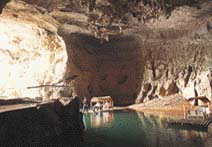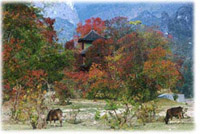History Guilin
Guilin was first established by Emperor Qinshihuang (214 BC) as the Guilin Shire. It was located on the Guixiang "Corridor" which was an important passage connecting Zhongyuan and Lingnan. During the Three-Kingdom period, the Wu Kingdom built up Shi'an Shire here, and from then on Guilin has come to be a political and transition center. Till Tang Dynasty, Guilin had become a relatively big city with great halls and walls. In Song Dynasty Guilin was the capital of Guangnanxilu, which governed Guangxi and Hainan Island. In Ming Dynasty, Guilin was also the seat of Jingjiang Prince Mansion and Guangxi Three Departments. Emperor Yongli had been here twice. Our revolutionary pioneer Sun Yat-san had his residence set up here and directed the northward expedition. In 1940 Guilin was reset as a city and the capital of Guangxi Province.
So Guilin has been the political, economic and cultural center in northeast Gui Region ever since its founding.
Geography Guilin
Guilin is situated in the northeast of Guangxi Province and southwest of Nanling Mountains. It is in the basin surrounded by Yuecheng Range, Ocean Hill, Jiaqiao Range and Tianping Hill. It appears at the southern end of Gui-Xiang Corridor. Carbonate rocks form the main body of the city ground where the karst physiognomy spreads widely, and there are many complete and wonderful karst sites, which have highly scientific value and tourist value. |
|
Climate Guilin
Guilin is in subtropical and monsoon zone with warm and moist surrounding, so it is not very cold in winter and not very hot in summer. There are little snow and evergreen trees. It also has plenty of rainfall with an average precipitation per year of 1,872 mm.
Natural and Ecological Environment Guilin
|
Karst caves and stone forests feature the wonderful natural ecological environment of Guilin, whose altitude is 140-160 meters. Li River is meandering through Guilin from north to south, with a yearly sand content of 0.067kg/m3 and strong self-cleaning ability. The earth consists of mainly red soils, with PH ranging from 4.5 to 6.5. The plants in Guilin belong to the southern green plants of the sub-tropical evergreen forests, |
with a variety of 2,329 species, which fall into 247 divisions and 969 sections. There are 1,593 kinds of animals in Guilin, falling into 60 divisions and 295 subdivisions.
Economy Guilin
The key points of Guilin's economy are tourism and agriculture. Its new economic advantage is the modern industry featured by high technology and the tertiary industry characterized by tourism trading and service. In 1998, the GDP of the city amounted to 29.142 billion yuan, and the fixed capital in vestment was 6.366 billion yuan. The gross production of grain went up 50 2.183 million tons, meat 640 thousand tons, and aquatic products 71.9 thousand tons. The gross production of agriculture totaled 16.523 billion yuan, and that of industry was 35.43 billion yuan. The income of tourism was 3.193 billion yuan.
Culture Guilin
Guilin has a long history and brilliant culture. To the north of Guilin City, there are Baojiyan Cultural Site in Old Stone Age 30,000 years ago and Zengpiyan Cultural Site in New Stone Age 9,000 years old, which provide precious data to the research of pre-historical culture in South China. After the construction of Lingqu Canal in Qin Dynasty, Guilin has shown its state of cultural exchange between South and North. Guilin mountains and rivers as the best scenery attracted a lot of famous poets in Tang Dynasty. The poems and essays they wrote added charming brilliance to the Guilin mountains and rivers, forming a unique culture of mountains and rivers. At that time in Guilin, the culture of Buddhism was flourishing. In Song and Yuan Dynasty, the culture in Guilin made greater progress and was listed on the top in the country. In Ming and Qing Dynasty, Guilin became a key cultural city in Lingnan. The education in Guilin is so developed that it is also called the Zhuangyuan City. There are also many famous painters of whom over one hundred have their names in history. The Gui Opera, Cai Tone, drama and mass cultural activities are very popular and lasting.
A Survey of Tourist Industry Guilin
Guilin is an ancient cultural city with a history of 2,110 years. The development of tourist resources could be dated back to the second year of Jingping of the Song State in Southern Dynasty (424 AC). Till Tang Dynasty, the Guilin mountains and rivers had been famous all over the country. During Song, Yuan, Ming and Qing.
Dynasties, both the natural and cultural tourist recourses in Guilin were significantly developed, and tourist activities were rich and colourful. The tourism of Guilin continued to develop in later period. In 1948, China Travel Service, Guilin Branch was founded and began to operate, signifying that the modern professional travel service came into being in Guilin.
After the liberation, the municipal government emphasized that tourism should be the pillar industry of Guilin, and consequently formulated the construction of scenic spots and the development of tourism. In the city projects of 1965, 1970 and 1975, Guilin was separately defined as the Landscape Tourist City, the Socialist Landscape City and Socialist Scenery Tourist City. On 23rd of October in 1985, the State Council defined Guilin as a Key Scenery Tourist City and Historical Cultural Famous City of China. In 1986, the State Council listed Guilin as one of the seven key tourist construction cities during the period of the seventh Five-year Plan. In 1985 and 1991, Guilin mountains and rivers ranked the second place both in the top ten Places of Interests and in the Forty Best Tourism Attractions in China. In 1998, China National Tourism Administration conferred Guilin as one of the Top Tourist Cities in China.
During the process of developing tourist industry, Guilin attaches great importance to the construction of tourist attractions, the maintaining of Li River, and the perfecting and improving of the tourists' reception capacity. After over 20 years' development, Guilin makes remarkable progress in tourist industry, basically forming a multi-functional and multi-level industry system and overall and high-quality tourist reception capacity. Guilin has become a world-renowned tourist city. During the recent years, Guilin always ranks within top 10 in terms of international tourist arrivals. International tourist arrivals amounted to 410,000 and domestic tourists reached 6 million in 1988 in spite of the influence of the financial crisis in southeast Asian countries.
Guilin has 28 star-rated hotels with 13,621 beds, 18 international travel services, 65 domestic travel agencies, 430 hotels and guesthouses for tourists, 15 coaches and cruises companies and over 1,000 tour guides who can speak foreign languages. About 40,000 people are directly involved in tourist industry. Besides, the economic benefits of Guilin City increased annually. The total revenue of tourist industry touched 1.18 billion yuan in 1997 and still achieved 0.921 billion yuan in 1998 in spite of the influence of the turmoil of southeast Asian countries. Tourism infrastructure improves steadily in recent years. The completion of the Liangjiang International Airport, Guilin Expressway and Guilin Railway Station eases the transportation congestion. Guilin has more than 40 air routes directed to big cities both at home and abroad. The postal and telecommunication industry also gains its rapid progress. The total installment capacity of program-controlled telephone of Guilin City has amounted to 135,000 and wireless telephones have been installed on the cruises on the Li River, which offers great convenience to tourists.
City Flower of Guilin-Sweet Osmanthus Guilin
Sweet Osmanthus is the city flower of Guilin. It is an evergreen plant and belongs to Sweet Osmanthus genus and Sweet Osmanthus family. Guilin has many Sweet Osmanthus tree forests, hence the name of Guilin (Forest of Sweet Osmanthus trees).
The history of Sweet Osmanthus in Guilin can be traced back to 10,000 years ago. Pollen had been discovered in the relics of Zengpiyan Cave of the New Stone Age located to the south of the city. Guilin has been enjoying a fame of "home of Sweet Osmanthus" for a long time.
Symbol of Guilin
The logo features the characteristics of Guilin City. It uses the image of Sweet Osmanthus as the outline and the symbolic Elephant-trunk Hill and its reflections on the river is in the middle of the logo. The logo is not only significant, but also fully illustrates the beautiful views of the city.
|







